- Analytics
- News and Tools
- Market News
- USD/JPY Price Forecast: Slips on soft US PMIs, drops below 144.00
USD/JPY Price Forecast: Slips on soft US PMIs, drops below 144.00
- USD/JPY falls to 143.45 after reaching a daily high of 144.46, pressured by softer US data fueling Fed rate cut speculation.
- Technical outlook remains bearish, with momentum favoring sellers as the pair fails to clear resistance at 143.81 (Kijun-Sen).
- Key support levels include the Senkou Span A at 142.92 and the Tenkan-Sen at 142.03, with further downside targeting 141.73 and 139.58.
The USD/JPY snapped two days of gains and dropped late in the North American session following softer-than-expected US economic data, fueling rate cut speculation by the Federal Reserve. At the time of writing, the pair trades at 143.45 after hitting a daily high of 144.46.
USD/JPY Price Forecast: Technical outlook
From a technical standpoint, the USD/JPY is downward biased despite printing a leg-up after bouncing from the September 16 low of 139.58 to the September 20 high of 144.49. It should be said that the rally continued to remain capped by the Kijun-Sen at 143.81, opening the door for further losses.
Momentum remains negative, as the Relative Strength Index (RSI) portrays. Therefore, tha path of least resistance is tilted to the downside.
The first support would be the Senkou Span Aat 142.92, followed by the Tenkan-Sen at 142.03, before challenging the September 20 swing low of 141.73. If surpassed, the USD/JPY could aim toward the September 16 pivot low of 139.58.
Conversely, if USD/JPY buyers move in and push prices above 144.00, further upside lies above the September 20 high of 144.49.
USD/JPY Price Action – Daily Chart
Japanese Yen FAQs
The Japanese Yen (JPY) is one of the world’s most traded currencies. Its value is broadly determined by the performance of the Japanese economy, but more specifically by the Bank of Japan’s policy, the differential between Japanese and US bond yields, or risk sentiment among traders, among other factors.
One of the Bank of Japan’s mandates is currency control, so its moves are key for the Yen. The BoJ has directly intervened in currency markets sometimes, generally to lower the value of the Yen, although it refrains from doing it often due to political concerns of its main trading partners. The current BoJ ultra-loose monetary policy, based on massive stimulus to the economy, has caused the Yen to depreciate against its main currency peers. This process has exacerbated more recently due to an increasing policy divergence between the Bank of Japan and other main central banks, which have opted to increase interest rates sharply to fight decades-high levels of inflation.
The BoJ’s stance of sticking to ultra-loose monetary policy has led to a widening policy divergence with other central banks, particularly with the US Federal Reserve. This supports a widening of the differential between the 10-year US and Japanese bonds, which favors the US Dollar against the Japanese Yen.
The Japanese Yen is often seen as a safe-haven investment. This means that in times of market stress, investors are more likely to put their money in the Japanese currency due to its supposed reliability and stability. Turbulent times are likely to strengthen the Yen’s value against other currencies seen as more risky to invest in.
© 2000-2025. All rights reserved.
This site is managed by Teletrade D.J. LLC 2351 LLC 2022 (Euro House, Richmond Hill Road, Kingstown, VC0100, St. Vincent and the Grenadines).
The information on this website is for informational purposes only and does not constitute any investment advice.
The company does not serve or provide services to customers who are residents of the US, Canada, Iran, The Democratic People's Republic of Korea, Yemen and FATF blacklisted countries.
Making transactions on financial markets with marginal financial instruments opens up wide possibilities and allows investors who are willing to take risks to earn high profits, carrying a potentially high risk of losses at the same time. Therefore you should responsibly approach the issue of choosing the appropriate investment strategy, taking the available resources into account, before starting trading.
Use of the information: full or partial use of materials from this website must always be referenced to TeleTrade as the source of information. Use of the materials on the Internet must be accompanied by a hyperlink to teletrade.org. Automatic import of materials and information from this website is prohibited.
Please contact our PR department if you have any questions or need assistance at pr@teletrade.global.
















